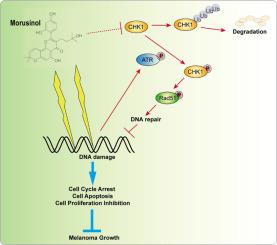Phytomedicine ( IF 6.7 ) Pub Date : 2023-03-16 , DOI: 10.1016/j.phymed.2023.154765 Leiyang Guo 1 , Zhen Dong 2 , Xiaolin Zhang 3 , Yuanmiao Yang 4 , Xiaosong Hu 4 , Yacong Ji 5 , Chongyang Li 4 , Sicheng Wan 4 , Jie Xu 4 , Chaolong Liu 4 , Yanli Zhang 5 , Lichao Liu 5 , Yaqiong Shi 5 , Zonghui Wu 3 , Yaling Liu 5 , Hongjuan Cui 2

|
Backgroud
Flavonoids have a variety of biological activities, such as anti-inflammation, anti-tumor, anti-thrombosis and so on. Morusinol, as a novel isoprene flavonoid extracted from Morus alba root barks, has the effects of anti-arterial thrombosis and anti-inflammatory in previous studies. However, the anti-cancer mechanism of morusinol remains unclear.
Purpose
In present study, we mainly studied the anti-tumor effect of morusinol and its mode of action in melanoma.
Methods
The anti-cancer effect of morusinol on melanoma were evaluated by using the MTT, EdU, plate clone formation and soft agar assay. Flow cytometry was used for detecting cell cycle and apoptosis. The ɣ-H2AX immunofluorescence and the alkaline comet assay were used to detect DNA damage and the Western blotting analysis was used to investigate the expressions of DNA-damage related proteins. Ubiquitination and turnover of CHK1 were also detected by using the immunoprecipitation assay. The cell line-derived xenograft (CDX) mouse models were used in vivo to evaluate the effect of morusinol on tumorigenicity.
Results
We demonstrated that morusinol not only had the ability to inhibit cell proliferation, but also induced cell cycle arrest at G0/G1 phase, caspase-dependent apoptosis and DNA damage in human melanoma cells. In addition, morusinol effectively inhibited the growth of melanoma xenografts in vivo. More strikingly, CHK1, which played an important role in maintaining the integrity of cell cycle, genomic stability and cell viability, was down-regulated in a dose- and time-dependent manner after morusinol treatment. Further research showed that CHK1 was degraded by the ubiquitin-proteasome pathway. Whereafter, morusinol-induced cell cycle arrest, apoptosis and DNA damage were partially salvaged by overexpressing CHK1 in melanoma cell lines. Herein, further experiments demonstrated that morusinol increased the sensitivity of dacarbazine (DTIC) to chemotherapy for melanoma in vitro and in vivo.
Conclusion
Morusinol induces CHK1 degradation through the ubiquitin-proteasome pathway, thereby inducing cell cycle arrest, apoptosis and DNA damage response in melanoma. Our study firstly provided a theoretical basis for morusinol to be a candidate drug for clinical treatment of cancer, such as melanoma, alone or combinated with dacarbazine.
中文翻译:

从桑白皮中提取的桑葚素通过遍在蛋白-蛋白酶体途径抑制 CHK1 降解黑色素瘤中的 DNA 损伤反应,从而诱导细胞周期停滞和细胞凋亡
背景
黄酮类化合物具有多种生物活性,如抗炎、抗肿瘤、抗血栓形成等。Morusinol 是一种从桑树根皮中提取的新型异戊二烯类黄酮,在前期研究中具有抗动脉血栓形成和抗炎作用。然而,桑酚的抗癌机制尚不清楚。
目的
在本研究中,我们主要研究了桑松酚对黑色素瘤的抗肿瘤作用及其作用机制。
方法
采用MTT、EdU、平板克隆形成和软琼脂试验评价桑叶松酚对黑色素瘤的抗癌作用。流式细胞术用于检测细胞周期和凋亡。采用 ɣ-H2AX 免疫荧光和碱性彗星试验检测 DNA 损伤,Western blotting 分析用于研究 DNA 损伤相关蛋白的表达。CHK1 的泛素化和转换也通过使用免疫沉淀法检测。细胞系衍生的异种移植 (CDX) 小鼠模型用于体内评估桑诺对致瘤性的影响。
结果
我们证明,桑诺不仅具有抑制细胞增殖的能力,而且还可以诱导细胞周期停滞在 G0/G1 期、半胱天冬酶依赖性细胞凋亡和人黑色素瘤细胞中的 DNA 损伤。此外,桑叶酚在体内有效抑制黑色素瘤异种移植物的生长. 更引人注目的是,在维持细胞周期的完整性、基因组稳定性和细胞活力方面发挥重要作用的 CHK1 在莫鲁西诺处理后以剂量和时间依赖性方式下调。进一步的研究表明,CHK1 被泛素-蛋白酶体途径降解。此后,通过在黑素瘤细胞系中过表达 CHK1,桑诺诱导的细胞周期停滞、细胞凋亡和 DNA 损伤得到了部分挽救。在此,进一步的实验证明,桑叶松酚增加了达卡巴嗪 (DTIC) 对黑色素瘤体外和体内化疗的敏感性。
结论
Morusinol 通过泛素-蛋白酶体途径诱导 CHK1 降解,从而诱导黑素瘤细胞周期停滞、细胞凋亡和 DNA 损伤反应。我们的研究首先为莫鲁西诺单独或联合达卡巴嗪作为临床治疗黑色素瘤等癌症的候选药物提供了理论依据。






























 京公网安备 11010802027423号
京公网安备 11010802027423号